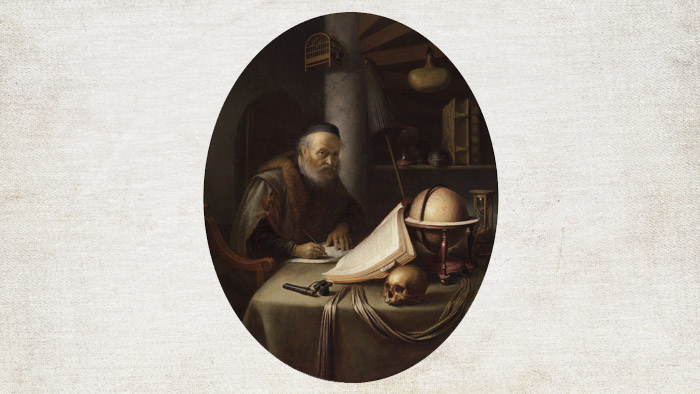
The beauty, elegance, and revolutionary art of some of history's greatest masters will be on full display as part of Louvre Abu Dhabi's first international exhibition of 2019.
'Rembrandt, Vermeer & the Dutch Golden Age: Masterpieces from The Leiden Collection and the Musée du Louvre’ will open on February 14, 2019 and will feature masterpieces from a total of 95 artworks, including paintings, drawings and objects including 22 created throughout the career of Rembrant van Rijn. In addition to The Leiden Collection and the Musée du Louvre, pieces from the Rijksmuseum and the Bibliothèque Nationale de France will also be exhibited.
The exhibition will also be the first time in 300 years that Johannes Vermeer's paintings 'Young Woman Seated at a Virginal' and 'The Lacemaker' will be displayed side by side.
H.E. Mohamed Khalifa Al Mubarak, Chairman of the Department of Culture and Tourism – Abu Dhabi, said, “The exhibition ‘Rembrandt, Vermeer & the Dutch Golden Age’ illustrates not only the importance of cross border cultural collaborations, but also how artistic creativity has always been at the heart of great historic moments.”
Jean-Luc Martinez, President-Director of the Musée du Louvre, added, "With its fifth exhibition, ‘Rembrandt, Vermeer & the Dutch Golden Age: Masterpieces from The Leiden Collection and the Musée du Louvre’, Louvre Abu Dhabi presents the finest works from the magnificent Leiden Collection alongside masterpieces from the Dutch collections of the Musée du Louvre, including Vermeer’s The Lacemaker."
The story of the Dutch Golden Age is at heart of its many masterpieces. Independence from Spain and a 17th century surge in global trade would have a significant impact on the Dutch, as their cities rose to become economic hubs as well as centres of learning and innovation. Amsterdam, Middelburg, and The Hague as well as others would find themselves among the richest places in the world. Dutch thinkers and architects gained prominence, including Baruch Spinoza and Jan Leeghwater. Others from across Europe flocked to Holland, with figures such as René Descartes feeling more at home with the Dutch than anywhere else.
It was during this vibrant era of new ideas and cultural evolution that artists were spurred, by their own creativity and wealthy patrons, to create some of art's most important works. Still life, landscapes, and historical works of art were all revolutionised by their concepts and trends.
The genius of the Golden Age's most prominent artists gave birth to new ways of seeing art and subsequently, the world. It is a vision that continues to inspire today.
Speaking about the predecessor state of the Kingdom of the Netherlands, Blaise Ducos, Chief Curator of Dutch and Flemish paintings at the Musée du Louvre, explained, “During the 17th century, exceptional economic, social and political circumstances enabled one country, The Republic of the United Provinces, to become the world’s leading economic power. The Dutch were living in what they considered a ‘Golden Age’. In this context, major artistic figures like Rembrandt or Vermeer flourished.
"Through the confrontation of masterpieces from the Musée du Louvre and The Leiden Collection, this exhibition tells this extraordinary story. This show does not intend to provide a panorama of Dutch painting in the 17th century, but by mentioning different glimpses, first and foremost through Leiden’s sight; it refers to the culture of artistic exchange within which Vermeer worked,” Ducos added.
Rembrandt's paintings will offer museum goers a firsthand look into his development as an artist. From early allegorical works to the legendary 'Self-Portrait With Shaded Eyes' and 'Minerva In Her Study', curators are aiming to show audiences Rembrandt evolution, one painting at a time.
Among the highlights from the Musée du Louvre’s collection that will be displayed are Vermeer’s 'The Lacemaker' (1669-70); Gerrit Dou’s' Self-Portrait with Palette in a Niche' (ca. 1660-65); and Ferdinand Bol’s 'Rebecca and Eliezer at the Well' (ca. 1645-46). Masterpieces from The Leiden Collection museumgoers won't want to miss include Rembrandt’s 'Self-Portrait with Shaded Eyes' (1634); Gerrit Dou’s 'Scholar Interrupted at His Writing' (ca. 1635); Jan Lievens’ 'Boy in a Cape and Turban' (ca. 1631); and Rembrandt's 'Young Lion Resting' (ca. 1638-42). The exhibition will also feature a rare 17th century ship model from the Rijksmuseum.
The exhibition will be divided throughout six sections: 'At the Heart of the Dutch Golden Age'; 'Extraordinary Beginnings: Rembrandt van Rijn in Leiden'; 'The Center of the Golden Age: Rembrandt van Rijn in Amsterdam'; 'Fine Painting in Leiden: Gerrit Dou, Frans van Mieris, and their Contemporaries'; 'Picturing Everyday life in the Dutch Republic'; and 'Historical Lessons and Tales of Morality'. By bringing together a wide variety of masterpieces, the exhibition will serve as a comprehensive introduction to the wonders of one of art history's most important eras. Audiences in the Gulf will soon be able to see firsthand the power, ingenuity, and enduring beauty of the Dutch Golden Age when 'Rembrandt, Vermeer & the Dutch Golden Age: Masterpieces from The Leiden Collection and the Musée du Louvre' opens in February. [email protected]